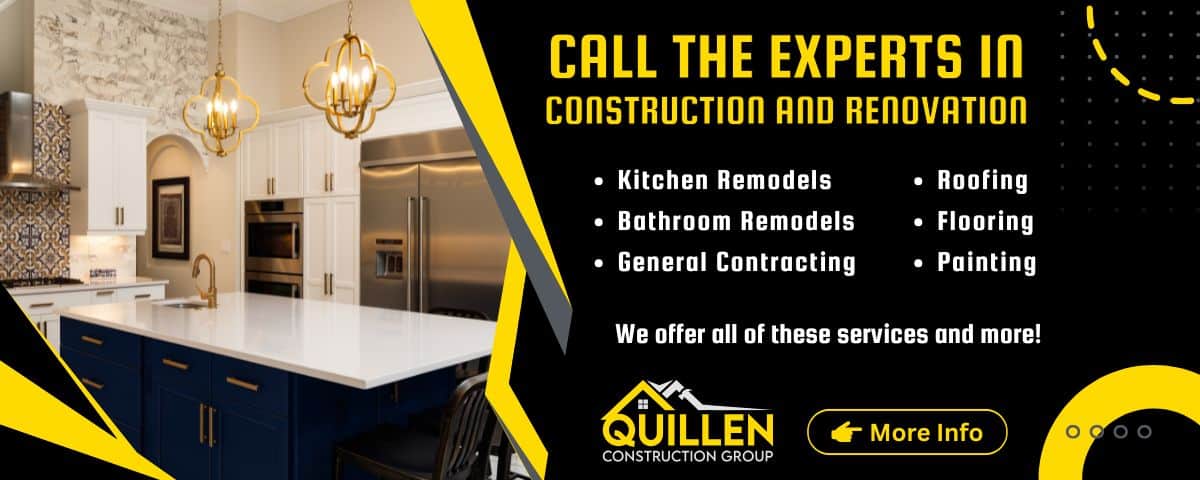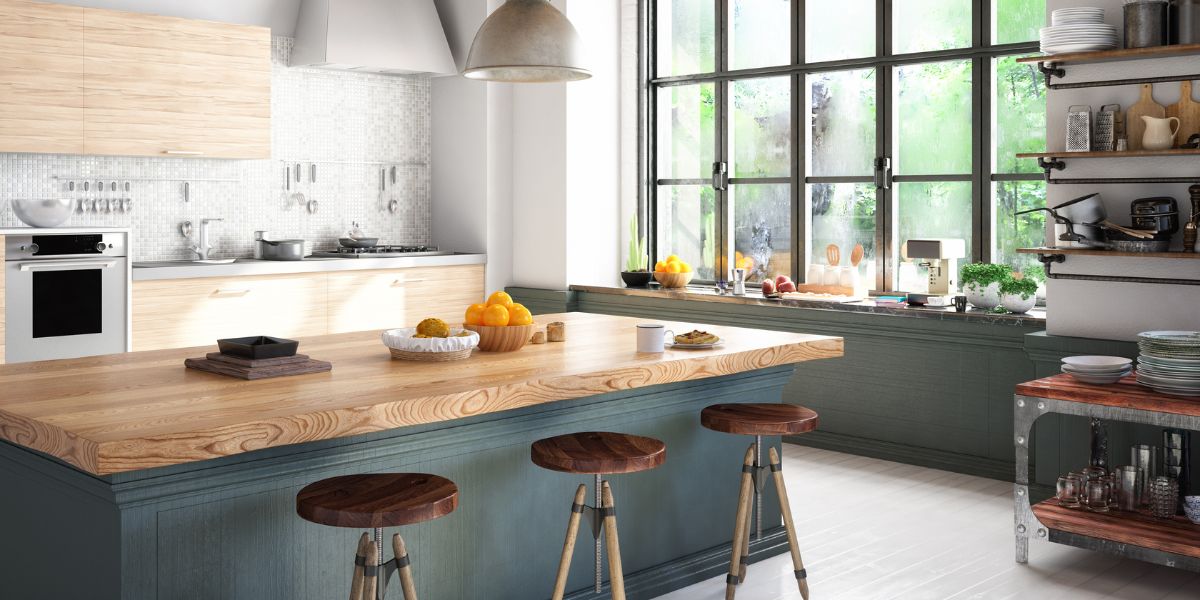When it comes to planning a kitchen remodel, color is one of the most transformative design elements at your disposal. Whether you prefer a modern, neutral palette or vibrant, personality-filled tones, the right color choices can redefine your space and set the tone for your entire home. With current kitchen remodeling trends emphasizing both individuality and harmony with natural materials, homeowners are increasingly exploring creative ways to bring color into the heart of their home.
If you’re working with a professional kitchen remodeling contractor, now is the perfect time to explore how subtle shades or bold hues can personalize your space while complementing functionality and style. In this article, we’ll explore practical tips and inspiring ideas for incorporating color into your kitchen remodel—from cabinets and backsplashes to accents and accessories.
Consider the Role of Color in Your Kitchen Design
Color isn’t just about style—it’s about how a space feels and functions. In the kitchen, where families gather, entertain, and spend a significant amount of time, color plays a crucial role in setting the mood and enhancing comfort.
Mood and Atmosphere
Warm tones like terracotta or ochre can create a cozy, welcoming environment, while cooler hues like soft blue or sage green can bring calm and clarity. Many modern kitchen remodeling trends include rich, nature-inspired tones that bring warmth without overwhelming the space.
Lighting Considerations
Natural and artificial lighting can dramatically alter the way colors appear. A soft gray may look sleek under LED lighting but appear dull in natural sunlight. Understanding how your chosen color palette interacts with light ensures your design looks good at every time of day.
Open Floor Plan Harmony
If your kitchen flows into a living or dining area, color should create cohesion rather than competition. Subtle transitions, such as keeping the same undertone across spaces, help maintain visual balance throughout the home.
Bold vs. Subtle: Choosing Your Color Strategy
There’s no one-size-fits-all approach when deciding how to use color in your kitchen. Your choice may depend on the style of your home, your personality, and how adventurous you want to be. Whether you opt for bold statement pieces or soft, neutral tones, the goal is a balanced, functional space.
Bold Choices
Bold colors—like deep navy, forest green, or even matte black—can bring dramatic flair. These are often used on base cabinets, islands, or accent walls. When paired with natural materials such as wood shelving or stone flooring, bold colors can create an elegant and grounded effect. For homeowners interested in staying ahead of the curve, experimenting with bold elements is a great way to embrace emerging kitchen remodeling trends.
Subtle Shades
On the other end of the spectrum, subtle shades like off-white, pale gray, or muted blush offer timeless appeal. These shades are particularly effective when paired with eco-friendly elements like bamboo flooring or recycled-glass backsplashes, enhancing a sense of natural serenity.
Balance and Contrast
The secret to a successful color scheme lies in contrast. A bold blue island can be grounded by soft white walls and warm, wood countertop materials. Similarly, adding color through accent pieces—think bar stools or decorative lighting—allows you to refresh the look over time without major renovations.

Key Areas to Incorporate Color
Adding color to your kitchen doesn’t have to mean painting every surface. In fact, some of the most impactful designs use color strategically in select areas. From cabinets to countertops, you can infuse personality and depth into your space while still maintaining elegance and functionality.
1. Cabinetry
Cabinets are one of the most visible—and customizable—features in any kitchen. They offer a large surface area for incorporating color, whether through a full palette or selective accents. Two-tone cabinetry, such as navy lower cabinets with white uppers, is a popular choice among current kitchen remodeling trends. If you want something more timeless, consider soft hues like sage, pale blue, or greige, which pair beautifully with natural materials like wood and stone.
2. Backsplashes
A colorful backsplash is a great way to add personality without overwhelming the room. Options range from hand-painted tiles to vibrant mosaics or even a single slab of dramatic stone with colorful veining. For an eco-friendly touch, consider recycled glass tiles, which come in a wide array of hues and patterns. These not only add flair but also support sustainable design goals.
3. Countertops
When selecting countertop materials for your kitchen, think beyond neutrals. While white quartz and classic granite remain popular, materials with natural movement—such as quartz with golden veining or soapstone with a bluish tint—can subtly introduce color. For a bolder approach, butcher block countertops stained in rich hues or even custom-dyed concrete options can make a powerful design statement while complementing other elements in the kitchen.
4. Open Shelving & Accents
If you’re hesitant to commit to bold colors in permanent fixtures, open shelving provides an excellent opportunity to showcase colorful dishware, glassware, or small décor items. Swapping out these accents seasonally lets you refresh the space regularly without needing a full remodel.
By focusing on these key areas, you can strategically incorporate color into your kitchen remodel in a way that’s both stylish and sustainable. Working closely with a skilled kitchen remodeling contractor ensures each element—from cabinet finish to countertop choice—aligns with your overall vision and lifestyle.
Color Trends to Watch
If you’re planning a kitchen remodel in the near future, staying up to date with kitchen remodeling trends can help you make choices that feel both fresh and timeless. Color trends in kitchen design are increasingly influenced by a desire for warmth, individuality, and a connection to nature.
Warm Neutrals Are Back
Cool grays and stark whites are being replaced by warmer tones—think creamy beige, soft taupe, and mushroom gray. These hues bring a cozier, more inviting atmosphere and pair beautifully with natural materials like oak, rattan, and stone. They’re especially effective in transitional kitchen designs that blend modern and traditional elements.
Earthy, Nature-Inspired Colors
Sage green, terracotta, rust, and deep clay tones are gaining traction as more homeowners look to bring the outdoors in. These shades work well with eco-friendly finishes and organic textures, reinforcing a sustainable lifestyle without sacrificing style.
High-Contrast Combinations
Bold color pairings like black and gold, navy and white, or emerald green with brass accents are on the rise. These combinations offer a striking look and are particularly well-suited to contemporary or modern farmhouse styles.
Colorful Appliances
Gone are the days when stainless steel was your only option. Manufacturers now offer ranges, refrigerators, and hoods in rich blues, fiery reds, and even pastel hues, allowing your appliances to double as design statements.
By incorporating these color trends, you can create a kitchen that feels stylish now and continues to look fresh for years to come.

Working with a Professional Designer or Contractor
Choosing the right color palette is just one piece of the puzzle. A skilled kitchen remodeling contractor will help you navigate the bigger picture—blending aesthetic decisions with practical planning and high-quality execution.
Customized Color Planning
Professional remodelers work with you to evaluate lighting, layout, and existing architecture to determine which colors will enhance—not overpower—your kitchen. They can provide paint samples, cabinet swatches, and digital mockups so you can confidently make design choices that suit your space.
Material Pairings That Work
Color doesn’t live in isolation. It interacts with texture, pattern, and finish. A contractor will help you choose complementary countertop materials, backsplash designs, and flooring that work in harmony with your chosen palette. For example, pairing matte black fixtures with light-stained wood or deep blue cabinets with marble-look quartz can create a high-end, cohesive aesthetic.
Eco-Friendly and Sustainable Options
If sustainability is a priority, your contractor can suggest eco-friendly paints, adhesives, and surfaces that reduce VOCs and environmental impact. Many natural materials such as reclaimed wood or recycled-content tile are now readily available in a variety of colors and styles.
Partnering with an experienced kitchen remodeling contractor ensures that your vision is translated into a space that’s as functional as it is beautiful.
Final Tips for a Cohesive Look
Incorporating color into your kitchen remodel should feel exciting—not overwhelming. The key is to create a cohesive design that aligns with your personal style while enhancing the functionality of the space. Here are a few final tips to ensure your color choices work harmoniously:
Stick to a Unified Palette
Choose a primary color and one or two accent shades to maintain visual consistency. Use your dominant color for larger elements like cabinets or walls, and reserve accent colors for backsplashes, bar stools, or light fixtures. A consistent palette ties the whole room together.
Use Color to Highlight Architecture
If your kitchen has unique architectural features—like a coffered ceiling, exposed beams, or a statement island—use color to draw attention to them. For example, painting an island a contrasting hue can turn it into a striking focal point.
Layer with Texture and Finish
Even neutral color schemes can come to life through textural variation. Combine matte cabinets with glossy subway tile or rough-cut wood shelving with polished stone counters. These layers of texture add richness and depth without requiring more color.
Don’t Forget the Décor
Small, easily changeable items—such as rugs, dishware, wall art, and window treatments—are perfect for introducing seasonal colors or following evolving kitchen remodeling trends without a major commitment.
Conclusion
Color is one of the most powerful tools in a kitchen remodel. Whether you’re drawn to rich, dramatic tones or prefer a soft, serene palette, thoughtful color choices can enhance your home’s style and make the kitchen a space you truly love. From carefully selected countertop materials to vibrant backsplashes and eco-conscious accents, there are endless ways to personalize your kitchen with color.
Working with an experienced kitchen remodeling contractor like Quillen Construction Group ensures that your project is both visually stunning and expertly built. Ready to bring your dream kitchen to life? Contact us today to schedule a consultation and start exploring the colorful possibilities.
